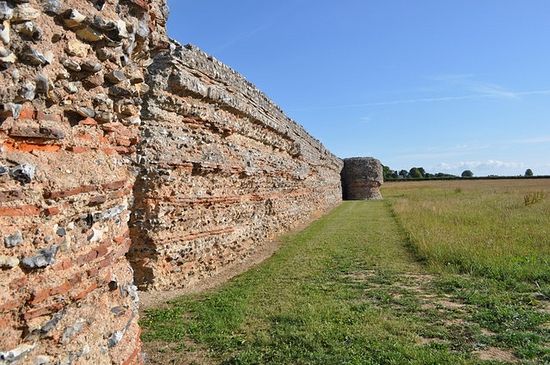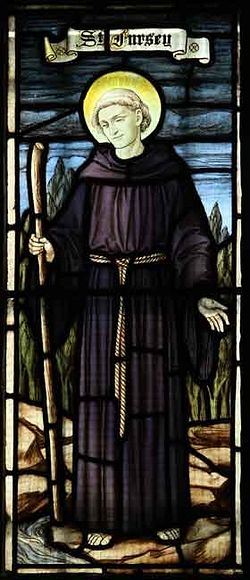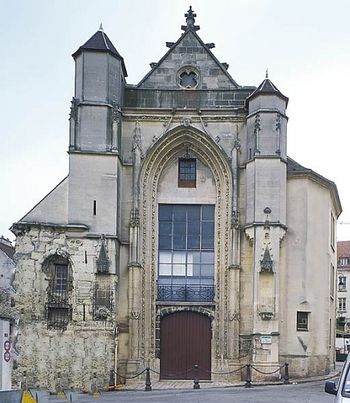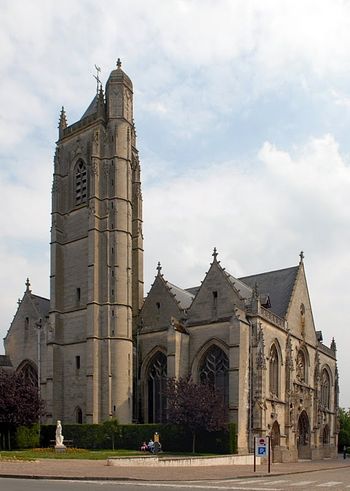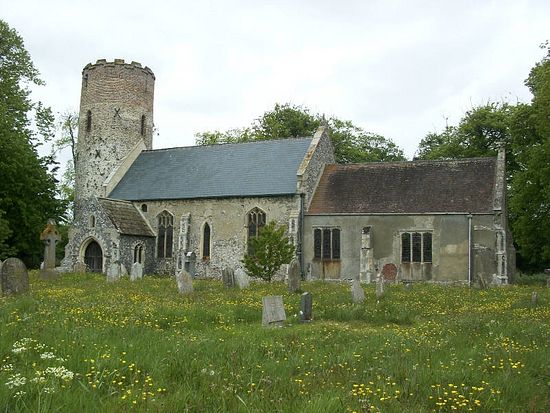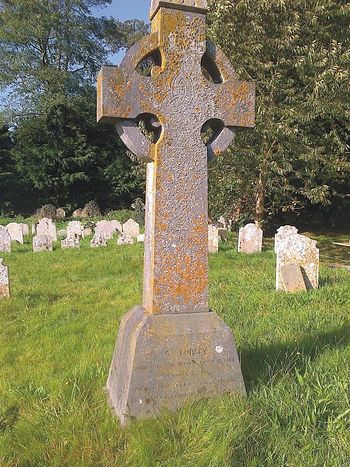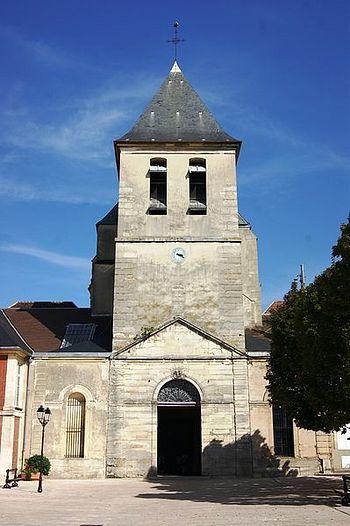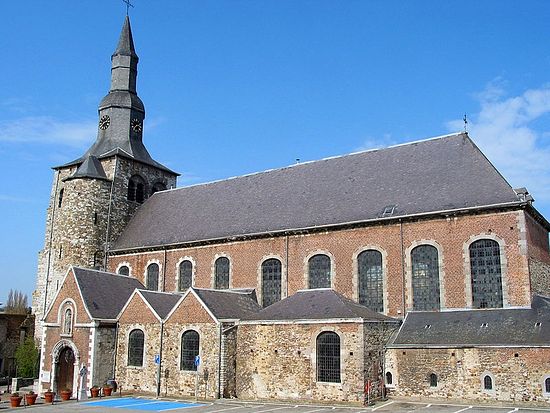St. Fursey (also Fursa, Fursy) was most probably born in about 567 in Ireland to a noble family. His father’s name was Fintan and his mother was called Gelges. His parents came from Munster. The infant Fursey was baptized by St. Brendan the Navigator, founder of Clonfert Monastery. When Fursey grew up he became a monk at Clonfert in Galway in Ireland, under the disciples of St. Brendan. The young monk was particularly interested in the Holy Scriptures. After Clonfert the future saint continued the monastic life on the island of Inisquin in Lough Corrib (a lake in western Ireland) under the guidance of an ascetic. Later Fursey was ordained priest.
Fursey spent most of his life in his native Ireland where he founded the famous Rathmat Monastery, probably in County Clare, which became a celebrated center of Irish monasticism. Ruling this monastery, the saint gathered numerous disciples around him and devoted much time to the Scriptures, prayer and contemplation. The brethren lived in simple wooden dwellings around the church, ploughed the land, kept cattle and did many other things. The monastery was famous for its ascetic traditions. Fursey is a great ascetic, visionary and one of the most brilliant preachers of Ireland who also evangelized parts of Britain and continental Europe. Fursey’s holiness was revealed from his childhood, and even as a young man he worked his first miracles.
From his youth the saint had regular visions of the spiritual world and of the afterlife. Often his soul left his body during the visions. Once angels lifted him into the air, singing heavenly songs: “The saints will go from virtue to virtue, the God of Gods will appear in Zion” and “Holy, holy, holy God the Lord of hosts.” Angels healed him from a grave illness. Another time an angel foretold his missionary future and gave him instructions, especially charging him with preaching repentance. In the same vision angels predicted to Fursey that Ireland would be stricken by famine and plague after his death. And the prophecy was fulfilled, as fourteen years after his repose a terrible yellow plague began on the emerald island. Once, in the city of Cork, Fursey was standing beside the grave of the great St. Finbarr of Cork when saw a golden ladder ascending right to the heavens, and the souls of pious men rising on it.
According to St. Bede of Jarrow (who writes about Fursey and praises him1 in his History of the English Church and People) and other early sources, Fursey experienced a vision of Paradise and hell: heavenly bliss and hellish torments, angels, demons and the souls of the departed—the righteous and the unrighteous. He was shown the unspeakable beauty of virtues and terrible ugliness of vices, especially of pride and disobedience. He witnessed long and detailed arguments between angelic and demonic powers regarding the fate of his soul and he was finally acquitted by angels and returned to earth for spiritual perfection and more zealous service to the Church. Angels revealed to the saint that every human soul will be tested after death by four fires that Fursey was shown: the first fire will scorch liars and those who break the vows they once made; the second fire will scorch misers, voluptuaries, and those who value earthly things more than heavenly and spiritual ones; the third fire will scorch squabblers and those spreading discord and strife; the fourth fire will scorch oppressors of the weak and offenders of the defenseless.
Not only angels, but also saints and righteous monks (departed shortly before the visions) appeared to Fursey and explained to him the basics of monastic life and the priestly ministry, and warned him about widespread mistakes and delusions that ascetics can encounter in the course of their spiritual life. Thus, they said that we have to cleanse ourselves from all spite and untruth first of all. They also said that spiritual labors, fasting and abstinence are good, but they are profitable only when we struggle with the greed, envy and lies inside us. Once demons wanted to seize him during his ascent to the light but angels prevented them from doing this. Another time demons scorched the saint’s shoulder and chin with fire because Fursey had taken something from the clothes of a sinful man right after the latter’s death. The angels witnessed that Fursey had done it not out of greed, but out of the desire to save the man and let him pass near the fire unharmed. But when the saint returned to his body, the marks on his shoulder and chin remained and were seen by his companions from that time on. The visions of St. Fursey were very popular across the Western Christian world throughout the Middle Ages, making him one of the most famous Irish saints. Some even say that these visions inspired Dante to write his Divine Comedy.
Before his departure from Ireland, Fursey travelled extensively across the country, blessed by angels to become “a wandering preacher for Christ”. Through his prayers the sick were healed and the possessed were delivered from the demons that had tormented them. On one occasion, Fursey raised two small children of a local ruler from the dead. Even his personal pastoral crozier healed the sick from various maladies when it was placed on them. For several years, Fursey led an ascetic solitary life on a tiny island in the ocean. Many place-names in the Irish counties of Louth, Galway and Cork are closely connected with him, thus confirming his missionary labors.
The saint tried to avoid fame. Thus, about the year 630, seeking solitude, he took his holy brothers Ultan and Foillan (who had become monks at Rathmat) and moved first to Wales, and then to the kingdom of the East Angles. The holy king Sigebert of East Anglia met the saint with great honor. Christianity had been introduced into East Anglia but the country was still mainly pagan. Fursey resolved with all his zeal to preach the Word of God to its inhabitants. Soon, together with his brothers and two other Irish disciples, Fursey founded a monastery. It was the first Irish monastery on English soil. According to tradition, it was situated within the abandoned third century Roman fort of Cnobheresburg, which is associated by many researchers with the present-day village of Burgh Castle near Great Yarmouth in the county of Norfolk, very near to the Suffolk border, at the estuary of the River Waveney. (Remarkably, it is not the only case when early missionaries established great monastic communities within Roman forts in Britain). It was the pious King Sigebert who bestowed this land to the missionaries. Thus, at Burgh Castle and elsewhere in East Anglia, Fursey together with his saintly brothers and disciples (Goban and Dicul) spread Christianity, helping the mission of the Burgundian Bishop St. Felix, “the Apostle of East Anglia”, whose main center was at Domnoc (probably Dunwich or possibly Walton near Felixstowe in Suffolk).
After St. Sigebert had been slain by pagans in 635, the mission of St. Fursey was wholeheartedly supported by his pious successor, King Anna of East Anglia. Fursey converted a very large number of East Anglians to Christ and performed many miracles. As the monastery gained in glory, Fursey, fearing human fame, retreated to a secluded place where he unceasingly prayed for a year together with his brother St. Ultan. Meanwhile, St. Foillan remained Abbot of Burgh Castle.
About the year 640, the Mercians headed by the pagan King Penda attacked East Anglia and the Irish missionaries could not stay in the English land any longer. Taking holy relics and other objects with them, Sts. Fursey, Ultan and Foillan moved to present-day France. Fursey hoped to continue his “desert life” in Europe and arrived in Neustria—the western part of the kingdom of the Merovingian Franks—where he was welcomed by King Clovis III (who ruled from 639 to 658; then only a small child) and the mayor of the palace Erchinoald, to whom most of the power belonged. Erchinoald gave the saint land for a new monastery, and Fursey early in the 640s established a monastery in Lagny (now Lagny-sur-Marne in the Seine-et-Marne department) on the River Seine, a few miles from Paris. This monastery gained wide popularity. At that time the area was rich in woods and vineyards. At Lagny the saint himself built three chapels: one was dedicated to the Savior, another one to St. Peter and the third one was later dedicated to St. Fursey. In the medieval period this monastery was known as the Abbey of St. Peter.
According to tradition, once Fursey struck the ground with his staff and suddenly a holy well gushed forth on that spot. In Neustria St. Fursey tirelessly preached, visited other monasteries and performed miracles until his death. He cured many sick, returned to life the only son of a Duke of Mezerolles, converted to Christ and guided to the path of salvation numerous sinners, criminals and robbers. St. Fursey reposed in the Lord as a very old man in about 648 or 650. During one of his journeys the holy man was stricken with a fatal illness. It is considered that the great ascetic passed away in the village of Mezerolles in the present-day Somme department of France (it was there that he had earlier raised the Duke’s son from the dead).
Fursey was buried in the monastery in Peronne in Picardy—another famous Irish monastery in Europe. It was said that the body of Fursey was not committed to earth for thirty days so that thousands of believers could bid farewell to their beloved teacher, and his relics remained absolutely incorrupt. Afterwards the monastery was called “Peronne of the Irish saints”. The monastery in Lagny founded by Fursey for a long time retained its status as one of the most prominent Irish Christian centers. St. Bede and other authors testified that Fursey’s relics produced a pleasant fragrance for many years after his demise. In 654 his relics were laid into a beautiful shrine in the shape of a little house, especially prepared probably by St. Eligius, the Enlightener of Flanders.
In 1056 the holy remains were laid in a splendid new shrine in Peronne, and again in 1256 under Louis IX (ruled from 1226 till 1270). Most of St. Fursey’s relics survived until the French Revolution. During the Revolution the reliquary with the saint’s head relic survived (as opposed to his main relics), and in 1870 during the bombardment of Peronne by the Prussians in the Franco-Prussian War the relic again remained whole, while the church was reduced to ashes! In all probability, part of the skull of the saint still exists and is kept at the Church of St. John the Baptist in Peronne to this day. In the Middle Ages Canterbury also claimed part of his relics. Another portion of St. Fursey's relics rests at the Notre Dame Cathedral of Amiens in France.
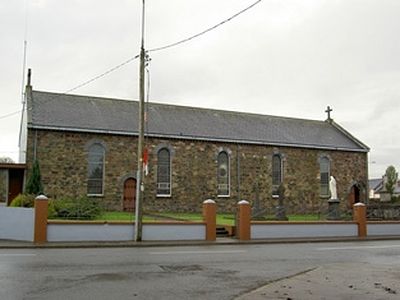 St. Fursey's Church in Banteer
St. Fursey's Church in Banteer
St. Fursey is still venerated in Ireland, England and France, where he is remembered in stained glass, frescoes, sculpture and other artworks, as well as in place-names. A number of parish churches in Ireland are dedicated to him. Thus, the Catholic church in the small town of Haggardstown in County Louth, built in 1853, bears his name. Another Catholic church in Banteer, County Cork, is dedicated to him, and there is a holy well of St. Fursey nearby. Two other wells which bear his name can be found at Clonmeenin in County Cork and Killurky West in County Kerry, where, it is believed, the saint was healed from blindness. Another ancient site closely associated with Fursey is Killursa in County Galway, where he may have founded one of his famous monasteries (its name means “church of Fursa”). Now ruins of a splendid early monastery church survive there, and it is considered that the saint had his vision of angels on this spot. The fabric of the church indicates that the monastery was rebuilt after the Norman Conquest, though some minor early Celtic elements can be seen as well. The monastery was dedicated to St. Fursey. There is a monument to the saint at the entrance to the ruins which are situated beside a cemetery. The nearest town is Headford.
The main center of veneration of St. Fursey in England is the village of Burgh Castle in Norfolk where he founded a monastery. The monastery existed probably till the ninth or tenth century. Now it is a very quiet and picturesque place. Three of four walls of the 3rd century Roman fort stand practically intact to this day and are open to the public. The recent archaeological excavations within the former fort revealed the existence of an early Christian cemetery and a Christian church on this spot, which more or less confirms early traditions connecting Burgh Castle with the three holy brothers.
There is an ancient parish church of Sts. Peter and Paul standing very near to the former fort. It may have been linked to the monastery. The earliest parts of this small and pretty church are of the late Saxon period, while other parts date from various periods. There are beautiful stained glass windows inside the church, one of which shows scenes of the life of Fursey. There is an exhibition dedicated to the saint inside. A Celtic cross in honor of St. Fursey stands in the churchyard. There is an annual pilgrimage to Burgh Castle arranged by Orthodox Christians. St. Fursey is depicted in the stained glass windows in a number of other East Anglian churches too. There is the tiny St. Fursey’s Orthodox community under the Patriarchate of Antioch nearby in Stalham in Norfolk.
He is the patron-saint of the towns of Peronne and Lagny-sur-Marne in France. A major street in Peronne is called “Rue Saint-Fursy”; there are also the fountain of St. Fursey and a street called “Rue de la Fontaine Saint Fursy” there. In Lagny-sur-Marne there are monuments closely connected with the former St. Fursey’s monastery. They include the Abbey Church of Our Lady of the Ardent, the city hall on the site of the monastery’s cloisters, and the fountain of St. Fursey. It is commonly believed that this fountain is fed by water from the holy spring founded by the saint himself. There is a modern Church of St. Fursey in this town. A street in Lagny-sur-Marne is also called Rue Saint Fursy, and a square bears his name also.
***
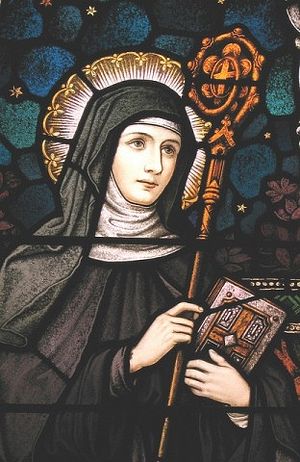 St. Gertrude of Nivelles, a stained glass
St. Gertrude of Nivelles, a stained glass
Later, following the martyrdom of his brother Foillan, which he saw in a vision, Ultan succeeded him as Abbot of Fosses. With time he also ruled over the monastery in Peronne, now in France. He reposed in the late seventh century and was buried in Fosses. St. Ultan is venerated in Ireland, eastern England, France and Belgium. The venerable Martyr Foillan (feast: October 31/November 13) was the brother or half-brother of Sts. Fursey and Ultan. He governed the monastery at Burgh Castle in East Anglia, and in about 640 travelled to Neustria, where he was received by Clovis. Then he proceeded to Belgium where St. Ita (also Iduberga), foundress of Nivelles Convent (mother of St. Gertrude; + 652, feast: May 8/21), granted him land in Fosses, and the saint founded a monastery there which became a center of evangelization. In Europe Foillan visited the monasteries of Peronne and Lagny and was successful in enlightening the Belgian province of Brabant. In about 655 St. Foillan was martyred by thieves in the forest of Seneffe outside Nivelles together with his two companions. Foillan who was buried in Fosses has been venerated as martyr since then. In Fosses-la-Ville there still stands a historic church dedicated to St. Foillan.
Thanks to the wandering Irish missionaries such as Fursey, Ultan and Foillan, the monasteries at Fosses and Peronne became celebrated centers of monasticism in Western Europe, and there were many other such centers in the region. In the seventh century Irish monks brought Celtic asceticism, learning, church vessels, holy books and various relics to Europe. Many of them built and organized monasteries in Europe on the model of Irish monasteries. These became great centers of monastic life, education, culture, and mission.
Holy Father Fursey, pray to God for us!

